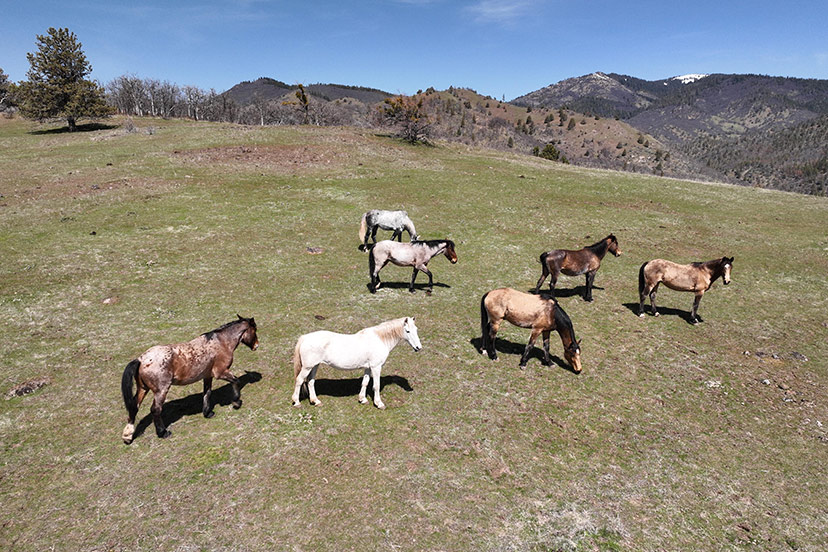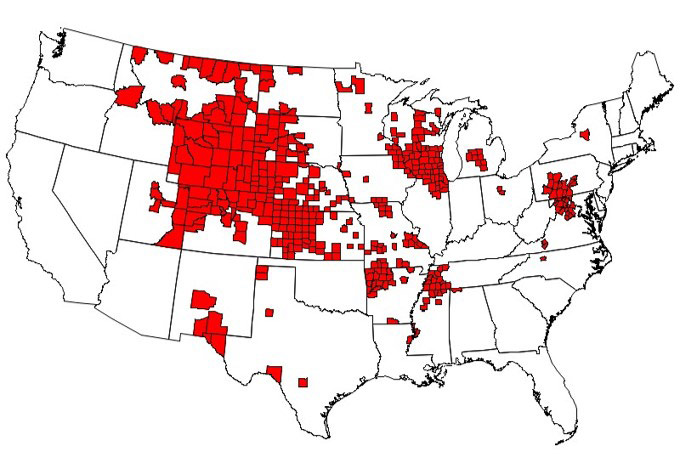PHOTO: Band of wild horses grazes wilderness area unsuited for ruminant livestock (cattle, sheep, goats). Courtesy William Simpson
It’s no surprise that cattle ranchers are promoting livestock grazing as a solution to wildfire. More cheap grazing on public lands benefits their revenue models.
And this rebuttal to the article published in Farm Progress promoting the concept of using invasive species ruminant livestock (cattle, sheep, goats) is not to condemn wildfire grazing by ruminant livestock — if used in the proper areas.
For the proper application of ruminant wildfire grazing to happen, all stakeholders need to have a clear understanding of the science that dictates the proper ecologically sensible management of the herbivory when used on various landscapes.
The application of ruminant grazers (cattle, sheep and goats) on the landscape is limited in scope.
This is because of the potential widespread ecological collapse and damage that would stem from the ultimate stripping of native cover crops vital to sensitive wilderness ecosystems. It’s a simple fact that in the light of logic and established science, any suggestion supporting potential widespread, one plan fits all, use of ruminant livestock is driven by monetary gain, and not by what’s best for any wilderness landscape and wildfire prevention.
Ruminant Grazers (cattle, sheep and goats) are fine in areas where cover crops can be managed and maintained via reseeding and managing the landscapes.
Maintaining good cover crops is important for many reasons including the health of forests, wildlife and watersheds. Good cover crops also aid in carbon sequestration and oxygen generation.
Making matters worse for remaining cervids in the already collapsed western populations comes when ruminant livestock are forced into wilderness areas against common sense.
As extensive history of land management shows, when livestock are introduced into deep wilderness, they suffer depredation by native apex predators. It’s at that point that livestock producers insist that the Apex predators be culled, leading to a sparse population of Apex predators. The subsequent reduction/elimination of Apex predators comes with serious unanticipated and deadly secondary effects for deer, elk… and even humans.
In wilderness areas (California has roughly 30 million acres of remote difficult terrain, Oregon has about 15 million acres) ruminant livestock grazing is ill advised due to resident predators that must remain in the habitats to control spreading Chronic Wasting Disease (CWD) in cervids (deer, elk, pronghorn, etc.). There is no treatment for Chronic Wasting Disease (a prion disease), and it’s 100% fatal. Bears, mountain lions, wolves, coyotes are evolutionarily equipped to quickly cull any diseased cervids. That rapid action prevents the spread of disease, in this case CWD, to the rest of the herd.
A recent article by the Center for Disease Control contains a map of the areas where CWD is epidemic in “at least 29 states”. Is it a coincidence that many of the areas, shown on the latest CDC map of serious CWD infection rates in cervid herds, align with major livestock grazing areas where Apex predators have been virtually eliminated?
And we must keep in mind the latency of data aggregation and publication. We know from recent published meetings by both California and Oregon state wildlife managers that they fear CWD might already be in those western states as well.
Humans can contract the disease by consuming meat from infected cervids. In humans, the disease is called Creutzfeldt-Jakob Disease (CJD). There is no treatment and it’s fatal in all cases. New research suggests that CJD is sometimes misdiagnosed as Alzheimers and other brain affecting diseases. Nevertheless, known diagnosed cases number in the hundreds each year.
The following is a quote from an official letter received by the author from Dr. Mark Zabel at the Prion Research Center:
While prion diseases affect many mammalian species, scientists have shown that equine species are extremely resistant to prion disease. This observation supports the idea of deploying wild horses into CWD endemic habitats to graze and consume a potentially significant source of environmental CWD prions, preventing consumption by CWD susceptible cervids.
Additionally the loss of native cover crops in wilderness areas via potential ruminant livestock grazing threatens the survival of native cover crops because ruminants digest most of the seeds of native flora, ending their life-cycles. This ruminant grazing action ultimately depletes the seed bank, resulting in a collapse of the density and diversity of native cover crop species.
Wild Horses are not ruminants. Horses don’t digest the native seeds like ruminants and instead, most of the seeds horses eat are reseeded intact onto the landscape via their dung. This function is critical to maintain ecosystems in remote wilderness and supports our collapsed cervid populations.
Such a collapse of native flora adversely impacts a host of co-evolved species, like deer, small mammals, birds and even pollinators. The loss of native cover crops and their diversity also adversely impacts the hydrology of the landscape, and can lead to adverse secondary and tertiary feedback impacts such as abnormal erosion that affects ground water stores, the spawning gravels of fisheries, forest health, and loss of native species co-evolved fauna that are dependent upon native plants and grasses.
This YouTube Video shows an example of the kind of remote, rocky, steep wilderness where wild horses can naturally manage wildfire fuels:
William E. Simpson II is a naturalist, author, and conservationist living in the Soda Mountain wilderness area among the wild horses that he studies. Learn more at Wild Horse Fire Brigade.


